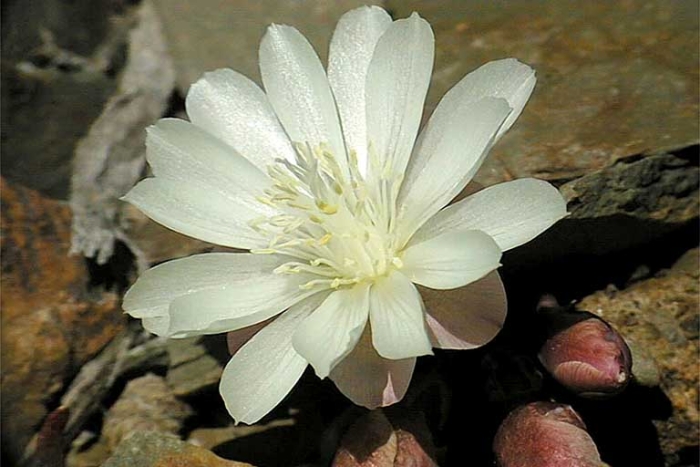Bitter Root
(Lewisia rediviva)
Bitter Root (Lewisia rediviva)
/
/

Larry Blakely
Public Domain
Image By:
Larry Blakely
Recorded By:
Copyright:
Public Domain
Copyright Notice:
Photo by: Larry Blakely | License Type: Public Domain | License URL: http://creativecommons.org/licenses/publicdomain/ | Attribution: 1999 Larry Blakely | Publisher: Calphotos |

































































Estimated Native Range
Summary
Lewisia rediviva, commonly known as Bitter Root, is an evergreen perennial herb native to dry, rocky slopes and mountainous regions in the Western United States, particularly in the Pacific Northwest and the Intermountain West. It is a small plant, typically growing to a height of 2 inches (5 centimeters) with a width of 3 inches (7.6 centimeters). The plant forms a low rosette of fleshy, linear leaves and produces a single, showy flower on each stem. The flowers have 5–9 oval-shaped sepals and petals that range in color from whitish to deep pink or lavender, blooming from April through July. The petals are oblong and measure 18–35 millimeters in length. After flowering, the plant produces egg-shaped capsules containing 6–20 nearly round seeds. The thick taproot allows the Bitter Root to endure arid conditions.
Bitter Root is valued for its drought tolerance and striking flowers, making it a choice plant for rock gardens, alpine collections, and xeriscaping. It requires minimal maintenance once established. The plant has historical culinary use by Native American tribes, who harvested the roots for food. In cultivation, it thrives in full sun with very low water requirements and prefers well-drained, sandy or gravelly soils. While generally disease-free, it can suffer from root rot if overwatered. It is not known for aggressive roots or significant pest problems.CC BY-SA 4.0
Bitter Root is valued for its drought tolerance and striking flowers, making it a choice plant for rock gardens, alpine collections, and xeriscaping. It requires minimal maintenance once established. The plant has historical culinary use by Native American tribes, who harvested the roots for food. In cultivation, it thrives in full sun with very low water requirements and prefers well-drained, sandy or gravelly soils. While generally disease-free, it can suffer from root rot if overwatered. It is not known for aggressive roots or significant pest problems.CC BY-SA 4.0
Plant Description
- Plant Type: Herb
- Height: 1-2 feet
- Width: 3-4 feet
- Growth Rate: Slow
- Flower Color: Pink, White
- Flowering Season: Spring
- Leaf Retention: Evergreen
Growth Requirements
- Sun: Full Sun
- Water: Very Low
- Drainage: Fast
Common Uses
Bee Garden, Butterfly Garden, Drought Tolerant, Edible*Disclaimer: Easyscape's listed plant edibility is for informational use. Always verify the safety and proper identification of any plant before consumption., Groundcover, Low Maintenance, Showy Flowers
Natural Habitat
Native to dry, rocky slopes and mountainous regions in the Western United States
Other Names
Common Names: Oregon Bitter-Root, Bitterroot, Bitter-Root, Oregon Bitterroot, Southern Lewisia, Léwisie À Racine Amère, Bitterrot
Scientific Names: , Lewisia rediviva, Lewisia alba,
GBIF Accepted Name: Lewisia rediviva Pursh